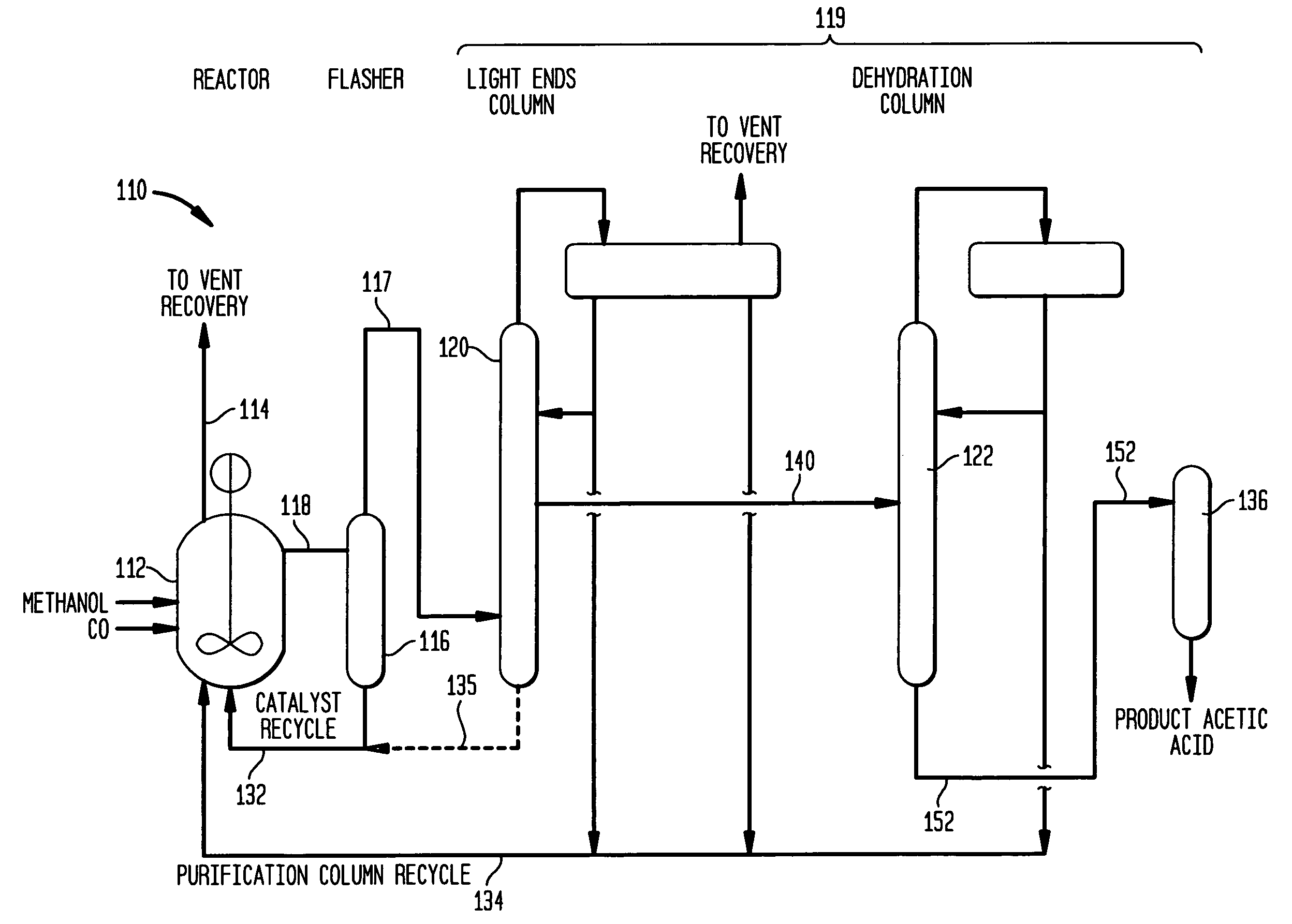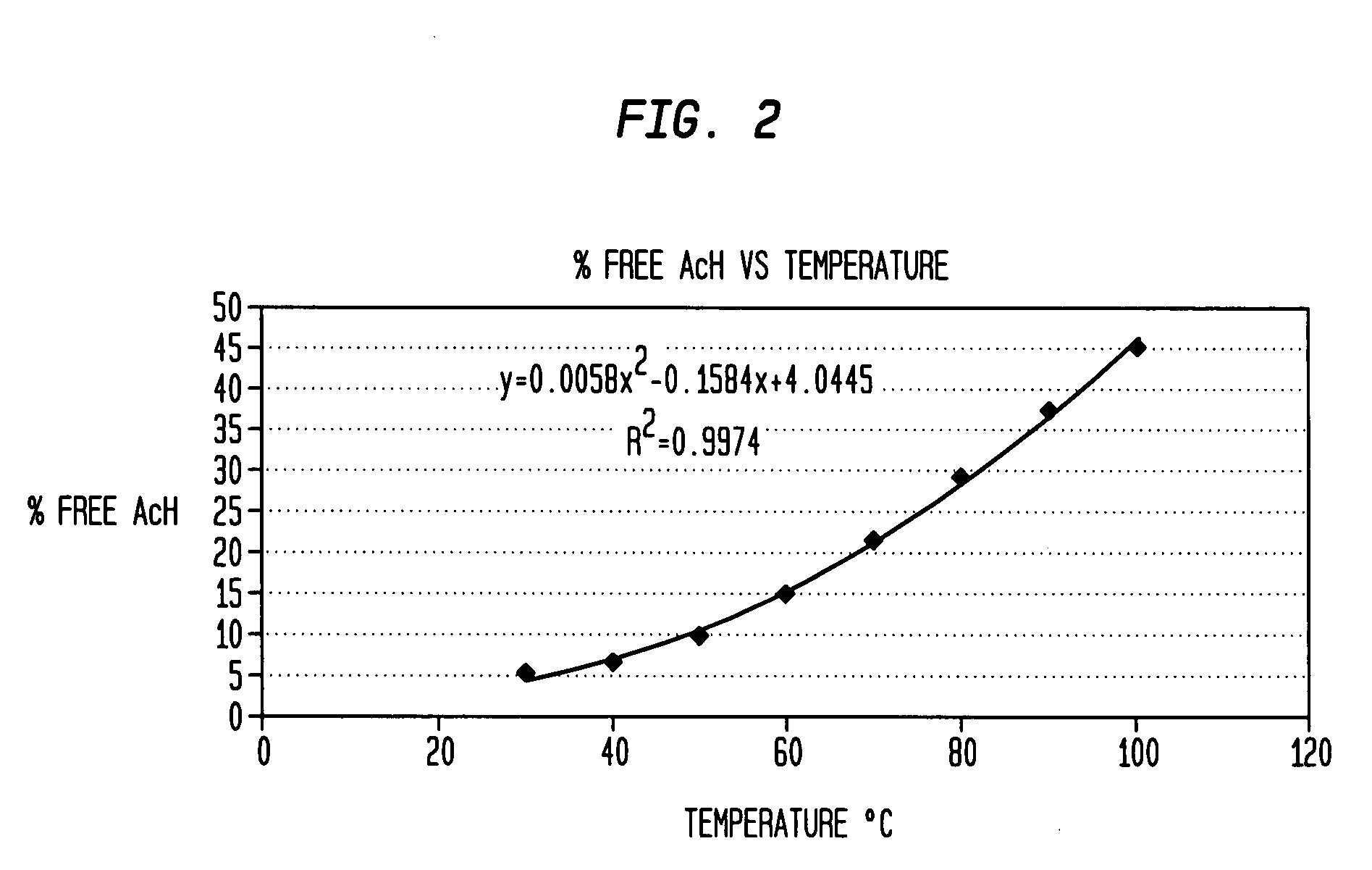Acetaldehyde removal from methyl acetate by distillation at elevated pressure
- Summary
- Abstract
- Description
- Claims
- Application Information
AI Technical Summary
Benefits of technology
Problems solved by technology
Method used
Image
Examples
example series a
Preliminary Hemiacetal Studies
[0034]An ultra-violet spectrometer was calibrated with solutions of acetonitrile and methanol at varying concentrations (0.5%-1.0%). After calibration, a solution of approximately 1 wt % AcH in methanol was transferred to a vial, sealed and placed in a GC oven at 60° C. for 15 minutes. After 15 minutes the vial was quickly taken out and used to fill a spectrometer cell. After a thermocouple was placed inside the cell as well, the spectrometer was closed and scans and temperature readings were taken. Results appear in FIG. 1, wherein it is seen that the absorbance of “free” AcH at 285 nM decreased with temperature as the sample cooled.
[0035]Further studies (Example series B) were conducted using a modified high pressure liquid chromatography apparatus equipped with a UV / visible photodiode array detector.
example series b
Secondary Hemiacetal Studies
[0036]The UV / visible photodiode array detector of a conventional HPLC (high pressure liquid chromatography) apparatus was calibrated using AcH standards prepared in HPLC grade acetonitrile. The standard solutions contained AcH concentrations in a range of from 0.1 wt % to 1.5 wt % to determine a Beer's Law molar absorptivity coefficient for AcH. Methanol solutions containing AcH concentrations in a range of from 0.5 wt % to 1.5 wt % were injected into the HPLC detector and absorbance readings were taken over a range of temperatures (30° C. to 100° C.). Results appear in FIG. 2 and Table 2, as well as FIG. 3.
TABLE 2Temperature Dependence of Free Aldehyde ConcentrationTemperature° C.Absorbancefree AcH (wt %)% free AcH302230.0906.01402640.1067.11503770.15210.2605590.22515.0707830.31621.18010530.42528.49013330.53835.910016000.64543.1
[0037]Equilibrium constants were calculated from the experimental data and Arrhenius plots of Ln Keq versus 1 / T ° K indicated a ...
examples 1-16
[0040]Referring to FIG. 4, a sixty (60) tray Oldershaw distillation apparatus 10 was used to distill ternary mixtures of MeAc, MeOH and AcH under pressure at elevated temperatures. Apparatus 10 includes a column 12 with sixty (60) trays provided with a feed inlet 14 at tray 40, an overhead outlet line at 16 and a residue outlet at 18. The overhead line is provided with a condenser 20 having an inlet 22 and an outlet 24 for coolant. Condenser 20 is coupled to a receiver 26 for receiving condensed overhead and providing it to a reflux line 28, which is optionally provided with a pre-heater 30.
[0041]Apparatus 10 was operated by feeding the ternary mixture MeAc, MeOH and AcH to inlet 14 of column 12, condensing column overhead in condenser 20 and feeding the condensed overhead as reflux through line 28 back to the column. Residue was withdrawn at 18, while condensed material was reboiled to maintain flux in the column.
[0042]A series of distillation runs were made at approximately 45 psi...
PUM
| Property | Measurement | Unit |
|---|---|---|
| Temperature | aaaaa | aaaaa |
| Temperature | aaaaa | aaaaa |
| Temperature | aaaaa | aaaaa |
Abstract
Description
Claims
Application Information
 Login to View More
Login to View More - R&D
- Intellectual Property
- Life Sciences
- Materials
- Tech Scout
- Unparalleled Data Quality
- Higher Quality Content
- 60% Fewer Hallucinations
Browse by: Latest US Patents, China's latest patents, Technical Efficacy Thesaurus, Application Domain, Technology Topic, Popular Technical Reports.
© 2025 PatSnap. All rights reserved.Legal|Privacy policy|Modern Slavery Act Transparency Statement|Sitemap|About US| Contact US: help@patsnap.com



